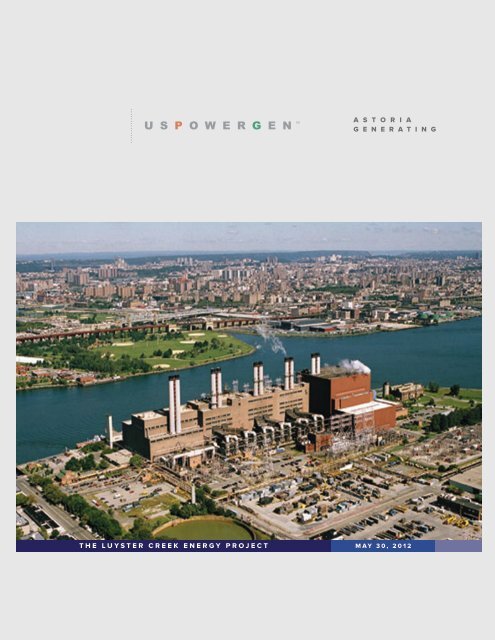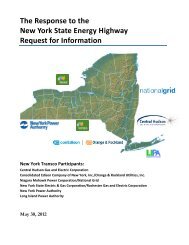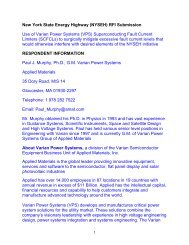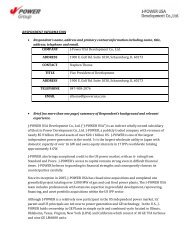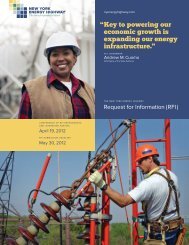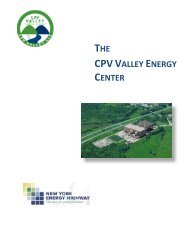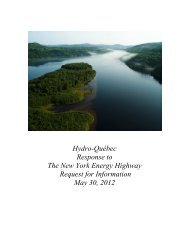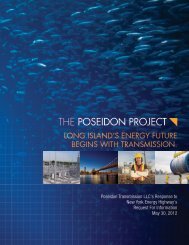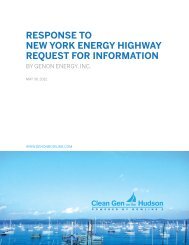THE LUYSTER CREEK ENERGY PROJECT ... - Energy Highway
THE LUYSTER CREEK ENERGY PROJECT ... - Energy Highway
THE LUYSTER CREEK ENERGY PROJECT ... - Energy Highway
You also want an ePaper? Increase the reach of your titles
YUMPU automatically turns print PDFs into web optimized ePapers that Google loves.
A S T O R I A<br />
G E N E R A T I N G<br />
<strong>THE</strong> <strong>LUYSTER</strong> <strong>CREEK</strong> <strong>ENERGY</strong> <strong>PROJECT</strong> MAY 30, 2012
A S T O R I A<br />
G E N E R A T I N G<br />
Existing Astoria<br />
Facility<br />
Introduction<br />
The Luyster Creek <strong>Energy</strong> Project<br />
The Luyster Creek <strong>Energy</strong> Project (LCEP) is a state-of-the-art repowering project designed to be<br />
the cleanest and lowest heat rate fossil fuel unit in New York City. The project will replace older<br />
less efficient generation and will reduce emissions through unit retirements and binding emission<br />
limits. LCEP, which will be a 410 MW combined cycle unit, is in the final stages of permitting.<br />
Building the project will create temporary construction jobs and 25-30 permanent union jobs. In<br />
addition, LCEP will improve the environment, use the most up-to-date electric generating technology<br />
available and provide affordable energy for New York City residents.<br />
<strong>THE</strong> <strong>LUYSTER</strong> <strong>CREEK</strong> <strong>ENERGY</strong> <strong>PROJECT</strong> MAY 30, 2012<br />
1
A S T O R I A<br />
G E N E R A T I N G<br />
New York State <strong>Energy</strong> <strong>Highway</strong><br />
Request for Information<br />
Response by Astoria Generating Company,<br />
a US Power Generating Company<br />
Luyster Creek <strong>Energy</strong> Project<br />
The New York State <strong>Energy</strong> <strong>Highway</strong> envisions public-private partnerships that provide reliable,<br />
affordable power to New York’s homes and businesses for the next half century while creating<br />
jobs, energizing private-sector investment and protecting the State’s environment and the wellbeing<br />
of its citizens.<br />
The RFI is looking for projects that<br />
Create jobs and opportunities for New Yorkers;<br />
Contribute to an environmentally sustainable future for New York State;<br />
Apply advanced technologies that benefit system performance and operations; and<br />
Maximize New York State electric ratepayer value in the operation of the electric grid.<br />
The Luyster Creek <strong>Energy</strong> Project is in the final stages of the permitting process. The benefits of<br />
LCEP include a reduction of existing air emissions while providing an increase in needed electric<br />
generating capacity of up to 235 MW 1 in a constrained sub-load pocket.<br />
The project will create several hundred temporary construction jobs and maintain existing permanent<br />
jobs at the Astoria facility, improve the environment, use the most state-of-the-art electric<br />
generating technology available and provide affordable energy.<br />
Respondent<br />
Information<br />
Astoria Generating Company, L.P., a USPowerGen Company<br />
John Reese, Senior Vice President<br />
300 Atlantic Street, 5th Floor<br />
Stamford, Connecticut 06901-3522<br />
jreese@uspowergen.com<br />
Telephone 212.792.0897<br />
Background and Experience<br />
Astoria Generating Company L.P. (AGC) is the wholly owned subsidiary of US Power Generating<br />
Company (USPowerGen), a privately held firm that owns, operates and develops electric<br />
generating facilities in areas with competitive wholesale markets. The management and operations<br />
teams at USPowerGen and AGC have substantial experience doing business in New York<br />
City and operating and developing generating facilities as well as implementing complex major<br />
projects.<br />
1<br />
The construction of the new 410 MW project will be partly offset by retirement of existing generation creating up to an<br />
incremental addition of 235 MW.<br />
<strong>THE</strong> <strong>LUYSTER</strong> <strong>CREEK</strong> <strong>ENERGY</strong> <strong>PROJECT</strong> MAY 30, 2012<br />
2
A S T O R I A<br />
G E N E R A T I N G<br />
AGC, acquired by USPowerGen on February 23, 2006, owns and operates fifty-three generating<br />
units at three facilities in New York City with a total summer capacity of over 2,164 Megawatts (MW)<br />
providing energy, capacity and ancillary services. These facilities operate in and generate electricity<br />
for New York City’s power market (Zone J), which is administered by the NYISO. The three facilities<br />
include the Astoria Generating Station (the “Astoria Facility”), the Gowanus Gas Turbine Facility<br />
(“Gowanus”) and the Narrows Gas Turbine Facility (“Narrows”). The Astoria Facility consists of five<br />
operating units (Units 20, 30, 40, 50 and GT-1) located in Astoria, New York. The five combined<br />
operating units have a summer capacity rating of 1,298 MW. Units 30, 40, and 50 operate as intermediate<br />
units, which run frequently, but are often used to follow load, ramping up during the peak<br />
and shoulder hours of the day and backing down or shutting off during most low load hours. Unit<br />
20 operates primarily as a peaking facility, running only during high load periods. Unit GT-1 is a 17<br />
MW natural gas-fired combustion turbine provides peaking power and black start capability. The<br />
generating units at the Gowanus and Narrows facilities are peaking units located in Brooklyn, New<br />
York. Gowanus has 32 units (16 dual-fuel) with a summer capacity rating of 559 MW and Narrows<br />
has 16 units (all dual-fuel) with a summer capacity rating of 307 MW.<br />
In addition to these facilities, AGC has two development projects each of which is being individually<br />
submitted in response to the Request For Information (RFI). The subject of this RFI submission<br />
is the Luyster Creek <strong>Energy</strong> Project and is described below. Additional information regarding<br />
the LCEP can be obtained at http://www.uspowergen.com/projects/luyster-creek/.<br />
<strong>THE</strong> <strong>LUYSTER</strong> <strong>CREEK</strong> <strong>ENERGY</strong> <strong>PROJECT</strong> MAY 30, 2012<br />
3
A S T O R I A<br />
G E N E R A T I N G<br />
<strong>PROJECT</strong><br />
DESCRIPTION<br />
Type of proposed project<br />
Electric Generation<br />
Size of proposed project, with expected capability in energy and capacity<br />
LCEP is designed to have capacity and energy output of 410 MW,<br />
Proposed project location<br />
LCEP will be located in NYISO Zone J at 18-01 20th Avenue, Astoria, Queens, New York. The project<br />
will be constructed at the current Fuel Oil Terminal Facility (FOTF) at the AGC Astoria Facility.<br />
Fuel source and availability of fuel/infrastructure, as appropriate<br />
LCEP will fire natural gas as its primary fuel and will utilize a supplementary natural gas-fired heat<br />
recovery steam generator (HRSG). A new aboveground fuel oil tank will also be constructed on<br />
the site for the storage of Ultra Low Sulfur Diesel fuel oil as a backup fuel.<br />
Earliest date project can be operational<br />
Commercial operation could begin within 26-30 months of project approval.<br />
Experience, market availability and suitability of project technology<br />
The Siemens SGT6-8000H combined cycle combustion turbine is the most advanced fossil<br />
fuel technology available on the market. The equipment‘s advanced compressor design and<br />
coatings along with enhanced sealing increases traditional combined cycle efficiencies. The<br />
Siemens H class provides operating flexibility including fast start up and cycling capability to<br />
support intermediate as well as continuous operation. The machine also has low level turndown<br />
capability that maintains high efficiency and low emissions. The low heat rates and unit flexibility<br />
make the Siemens H Class units well matched for the New York City market, displacing older units<br />
and responding to the reliability and market demands of the system. While the 50 Cycle Siemens<br />
H Class units have been in operation for several years the first 60 cycle units in the US are currently<br />
under construction. The units are readily available in the timeframe envisioned for the LCEP.<br />
Description of Proposed Project: Luyster Creek <strong>Energy</strong> Project<br />
The LCEP consists of the installation of a new highly efficient Siemens H-class combustion turbine<br />
operating in a combine cycle configuration with a generating capacity of approximately 410<br />
megawatts (MW) matched with an emissions reduction strategy.<br />
The existing Astoria Facility consists of three dual-fueled (natural gas and No.6 oil) boilers, one<br />
natural gas-fueled boiler and a small simple cycle CT, with a combined generating capacity of approximately<br />
1,300 MW. The FOTF is a parcel consisting of approximately 12.5 acres that is located<br />
approximately 2,400 feet to the northeast of the current Astoria Facility building. These parcels<br />
are connected by utilities and easements and have been determined to be contiguous and adjacent<br />
for air permitting purposes by the New York State Department of Environmental Conservation<br />
(NYSDEC). A new aboveground fuel oil tank would also be constructed at the FOTF for the storage<br />
of ultra low sulfur diesel (ULSD) fuel. Currently there are approximately 8 million gallons of No.6 oil<br />
storage at the FOTF in four tanks for the existing Astoria Facility Units. Those tanks will remain in<br />
service. Fuel is currently delivered by barge to the tanks from the adjacent A-10 dock and will be<br />
delivered from the same dock to the new tank. The unit will be dual-fuel-capable, using natural gas<br />
as a primary fuel, with ULSD as backup fuel to be used for up to approximately 30 days annually.<br />
<strong>THE</strong> <strong>LUYSTER</strong> <strong>CREEK</strong> <strong>ENERGY</strong> <strong>PROJECT</strong> MAY 30, 2012<br />
4
A S T O R I A<br />
G E N E R A T I N G<br />
One of the benefits of the LCEP is that it will provide new, high efficiency, clean electric generation,<br />
while reducing emissions. The potential emissions resulting from the additional generating<br />
capacity will be offset by implementing the strategies described below. These actions will fully<br />
address community concerns and ensure that total air emissions will be reduced by a combination<br />
of methods, including:<br />
1. Use of a high efficiency, low emissions combustion turbine technology.<br />
2. Establishment of enforceable emissions limits on existing Astoria Facility Units.<br />
3. Shutdown/retirement of existing Astoria Facility Unit 20.<br />
4. A permit cap on the sulfur content of the fuel oil.<br />
5. The LCEP equipment will employ air cooling. There will be no air emissions<br />
from the cooling system; the use of wet cooling would result in additional<br />
particulate emissions.<br />
Project<br />
Justification<br />
The LCEP responds to the objectives outlined in the RFI. More specifically it will;<br />
Reduce constraints on the flow of electricity to and within the downstate area;<br />
Assure long term reliability of the electric system; and<br />
Increase efficiency of power generation, particularly in densely populated<br />
urban areas.<br />
The New York State Reliability Council requires that 83% of the electrical power in New York City<br />
(City) or Zone J be supplied by units dedicated to supplying Zone J for system reliability. The<br />
Existing Astoria Facility Units are older, less efficient units that are generally used for reliability<br />
and high electric load days. Because the Siemens turbine is the most efficient unit commercially<br />
available, it will displace the operation of other generating units in the system, including both the<br />
older units in the City (including the existing Astoria Facility Units) and also existing combined cycle<br />
units which, even though more efficient than older steam generating units, are not as efficient<br />
as the LCEP. This displacement will provide a tremendous environmental benefit in reduced air<br />
emissions resulting from the generation of electricity. In addition to the environmental benefit,<br />
the cost of production of electricity would be reduced due to the higher efficiency of the LCEP<br />
equipment. Load profiles and existing capacity resources in the City require that the City have<br />
quick start and intermediate load generation capability to meet demand. The LCEP equipment<br />
will be designed to start up and shut down quickly, and will have greater operational flexibility<br />
than the standard combined cycle facilities currently operating in the City. This flexibility will reduce<br />
emissions during start up and shut down periods, and allow the LCEP equipment to be shut<br />
down if there are more economical sources available to operate during uneconomic periods.<br />
Additionally, the LCEP is consistent with New York City’s PlaNYC, and the New York State <strong>Energy</strong><br />
Planning process, providing cleaner, more reliable power and upgrading the energy infrastructure.<br />
AGC is increasing efficiency (replacing older less efficient generating capacity at the Astoria<br />
Facility with a new highly efficient Siemens H-class combustion turbine) operating in a combined<br />
cycle configuration. The H class combustion turbine is the most efficient machine available in<br />
<strong>THE</strong> <strong>LUYSTER</strong> <strong>CREEK</strong> <strong>ENERGY</strong> <strong>PROJECT</strong> MAY 30, 2012<br />
5
A S T O R I A<br />
G E N E R A T I N G<br />
today’s market. Because NYISO uses economic dispatch to schedule generation resources for<br />
operation and LCEP will be one of the most efficient and lowest cost unit in New York City, the<br />
LCEP will be one of the first units to be called to operate.<br />
Financial<br />
The likely financial plan and potential funding sources that would be needed for project success,<br />
including long-term contracts, structure and duration required.<br />
The project will utilize a traditional project finance structure. Equity will be funded from the balance<br />
sheets of AGC and USPowerGen, potentially in partnership with outside investors. Debt<br />
financing will be funded through the project finance bank market..<br />
A standard project finance would include a tenor of 5 – 8 years with an initial equity commitment<br />
of between 40% - 50% of the total project funding. A long-term contract of at least 5 years would<br />
be important to secure attractive financing terms.<br />
Name of potential Project Sponsor(s), if applicable, and Sponsor(s) financial commitment to the<br />
project<br />
AGC will be the main Project Sponsor, potentially in partnership with additional investors.<br />
Projected amounts of energy and capacity to be produced or delivered; identification of potential<br />
ancillary services and environmental attributes that may be available for sale of delivery.<br />
The project has a nameplate rating of 410 MW. It is anticipated that the project will be capable<br />
of providing 350 MW UCAP in the summer and 404 MW of UCAP in the winter. In addition, the<br />
project is capable of providing quick start, black start, voltage support and reserves.<br />
Potential sources of project revenue – As examples, whether the project is currently or expected<br />
to be in a New York State Public Service Commission (PSC) proceeding, or whether it<br />
would require a power purchase agreement with a creditworthy counterparty, or would rely on<br />
power merchant sales<br />
It is expected that the project will require some portion of the output to be secured with a power<br />
purchase agreement.<br />
Projected range of pricing for project products (i.e., energy, capacity, ancillary services and<br />
environmental attributes, if applicable).<br />
The project economics will benefit from the existing Astoria site infrastructure, including the<br />
point of interconnection, deliverability rights, land, gas pipeline, fuel oil storage, as well as shared<br />
personnel. These competitive cost advantages - in combination with the state-of-the-art, high<br />
efficiency generation technology - will enable the project to be very price competitive relative to<br />
all other units in New York City.<br />
Risk of price changes due to changes in prices for commodities, manufacturer quotations and<br />
other materials and services.<br />
The project will be constructed through an engineering, procurement, and construction (EPC)<br />
contract which will limit the risk from commodity, manufacturer quotation, and other material and<br />
service price changes. In addition, the existing infrastructure from AGC’s adjacent facilities, including<br />
a natural gas pipeline, 138 kilovolt (kV) electric transmission line, utility switchyard, water<br />
<strong>THE</strong> <strong>LUYSTER</strong> <strong>CREEK</strong> <strong>ENERGY</strong> <strong>PROJECT</strong> MAY 30, 2012<br />
6
A S T O R I A<br />
G E N E R A T I N G<br />
supply, sanitary wastewater discharge pipelines, oil storage, and existing operations and maintenance<br />
personnel to operate and maintain the new equipment will limit the scope of required<br />
construction and therefore reduce price risk.<br />
Anticipated incentives, such as applicable tax incentives and impact on pricing.<br />
It is anticipated that the project will qualify for the UTEP property tax exemption, for generation<br />
projects sited within Zone J.<br />
Options to reduce pricing and pricing uncertainty<br />
Equity and debt financing costs are driven by project risk. A Power Purchase Agreement with<br />
a longer duration and higher proportion of secured revenues will help to lower project risk and,<br />
therefore, lower the required contract pricing.<br />
Permit/Approval<br />
Process<br />
Federal, State and local permits needed to develop and operate the project<br />
Title V Permit Modification (6 NYCRR 201-6) (NYSDEC)<br />
Acid Rain Permit (known as Title IV) (6NYCRR 201-6) (NYSDEC)<br />
SPDES Permit Modification (6 NYCRR 750) (NYSDEC)<br />
SPDES General Permit for Storm water Discharge from Construction Activity (including<br />
SWPPP) (GP-10-01) Notice of Intent (NYSDEC)<br />
CO2 Budget Permit (6 NYCRR 242-3) (NYSDEC)<br />
Clean Air Interstate Rule (CAIR) NOX Annual Trading Permit (6 NYCRR 244-3) and CAIR<br />
SO2 Trading Permit (6 NYCRR 245-3) (NYSDEC)<br />
Updated Spill Prevention Control and Countermeasure (SPCC) Plan (40 CFR 112 and 6<br />
NYCRR 612-614) (NYSDEC)<br />
Bulk Petroleum Storage Tank Permit (FDNY) and Petroleum Bulk Storage Permit (NYS-<br />
DEC)<br />
New York State Chemical Bulk Storage (NH3 tank) Registration (6 NYCRR Parts 595-<br />
599) (NYSDEC)<br />
Waterfront Revitalization Program (WRP) Consistency Review (NYSDEC, NYSPSC)<br />
PSL Section 68 Certificate of Public Convenience and Necessity (NYSPSC)<br />
PSL Section 69 Approval (NYSPSC)<br />
Lightened Regulation Approval (NYSPSC)<br />
Increase water use connection/approval (NYCDEP)<br />
Fire Department Storage Permit (aqueous ammonia
A S T O R I A<br />
G E N E R A T I N G<br />
A Draft Scope of Work was issued by NYSDEC on July 7, 2010 and Final Scope issued<br />
on November 10, 2010<br />
AGC filed an Air Permit Application on August 30, 2010<br />
AGC filed a DEIS on December 14, 2010 and revised the document on May 20, 2011<br />
and June 30, 2011<br />
AGC filed a revised Air Permit Application on May 20, 2011 and June 30, 2011<br />
NYS DEC issued a Notice of Completion of the DEIS on June 29, 2011<br />
NYSDEC issued a draft Title IV and V Air permit on June 29, 2011<br />
NYSDEC held a public hearing on the DEIS on August 24, 2011<br />
LCEP has been assigned Queue position #361 by the NYISO<br />
On May 25, 2012 AGC submitted a revised Feasibility Study to the NYISO for their<br />
review.<br />
Other<br />
considerations<br />
Key uncertainties in federal, State and local project permitting and suggestions for how such uncertainties<br />
can be addressed<br />
The project has received draft air permits and has been through the public hearing and comment<br />
period on the DEIS. The remaining items to be addressed include the CO2 PSD requirement and<br />
some minor adjustments on overall emissions to achieve a net reduction which can be readily addressed<br />
in a short period of time. There are no major uncertainties remaining.<br />
Other Considerations, if applicable<br />
Issues or challenges the proposal faces and suggestions for how these issues and challenges<br />
can be addressed for the project and future projects.<br />
There are no other issues or challenges facing the LCEP other than market conditions.<br />
Additional<br />
Information<br />
Property<br />
Ownership of the potential project location(s), and the extent to which the project would utilize<br />
existing rights-of-way and/or previously disturbed land.<br />
The LCEP will be constructed on previously disturbed industrially zoned land that is<br />
owned by AGC.<br />
Projected in-service date and project schedule<br />
Timeline for development and financing of the potential project, culminating in the commercial<br />
operation of the project, that includes preliminary engineering and licensing, detailed engineering<br />
and design, permitting, procurement of major equipment, construction, testing and commissioning.<br />
Preliminary engineering has been completed to the point required to prepare and file<br />
the applicable permit applications. The permitting process is well advanced as noted<br />
above and should be completed in less than six months. An estimated time line is appended<br />
as attachment A.<br />
<strong>THE</strong> <strong>LUYSTER</strong> <strong>CREEK</strong> <strong>ENERGY</strong> <strong>PROJECT</strong> MAY 30, 2012<br />
8
A S T O R I A<br />
G E N E R A T I N G<br />
Interconnection<br />
Potential interconnection point(s)<br />
The LCEP equipment will be electrically interconnecting to the grid via existing connections<br />
from the existing Astoria Facility Units. The specific proposed Point of Interconnection<br />
(POI) is Con Ed’s Astoria West Substation via the existing Astoria West 138 kV<br />
Substation Unit 3 (A3) feeders 24121/24122.<br />
Respondent’s assessments of why such interconnection point(s) are optimum, from both an economic<br />
and reliability perspective.<br />
LCEP optimizes existing interconnection points and the existing infrastructure in the<br />
Astoria Complex.<br />
Respondent’s assessment of whether the energy and/or capacity is deliverable to the bulk electric<br />
system.<br />
AGC has determined that with a relatively minor amount of system upgrades both the<br />
energy and capacity of the LCEP are deliverable to the electric grid.<br />
Technical<br />
Anticipated life of facility components<br />
The LCEP will be designed for a useful operating life of approximately 30 years.<br />
Quality and duration of original equipment manufacturer warranties<br />
Final manufacturer warranties have not yet been negotiated; however, nothing less<br />
than industry standard warranties will be acceptable.<br />
Construction<br />
Opportunities for New York-based manufacturing and/or assembly of equipment<br />
It is anticipated that construction and equipment will result in an expenditure of $800<br />
million to $1.0 billion, of which it is estimated more than 25% is expected to be spent in<br />
the local New York Metropolitan Area. An effort will be made to identify local competitive<br />
suppliers. The local expenditures are expected to generate tens of millions in additional<br />
secondary, economic activity in the area. A Cornell study estimated additional<br />
economic activity from a project by applying the output multiplier (1.66). While this<br />
multiplier has some limitations, it is reasonable to assume half again as much economic<br />
activity will be created by the project due to the local expenditures and could result in<br />
hundreds of millions of dollars in local economic activity.<br />
Labor expenditures for construction of the LCEP Equipment will be a substantial portion<br />
of the total cost of the project. The majority of this labor cost is expected to be paid<br />
to labor provided from the metropolitan area. An effort will be made to hire locally. In<br />
addition to local temporary jobs, the community will also benefit from additional direct<br />
non-payroll expenditures.<br />
Description of potential contractual arrangement(s) during construction<br />
This project will be conducted under an EPC arrangement.<br />
<strong>THE</strong> <strong>LUYSTER</strong> <strong>CREEK</strong> <strong>ENERGY</strong> <strong>PROJECT</strong> MAY 30, 2012<br />
9
A S T O R I A<br />
G E N E R A T I N G<br />
Availability of labor, materials and installation equipment<br />
USPG has determined that there is adequate labor, material and equipment to construct<br />
the facility.<br />
Potential decommissioning options for removal of a project at the end of its life cycle, including<br />
designation of a potential responsible party from a cost and environmental perspective<br />
The LCEP unit will be designed for a useful operating life of approximately 30 years.<br />
During the life of the LCEP, maintenance and refurbishment of the components will be<br />
required. Near the end of its useful life, the primary components of the LCEP equipment<br />
could undergo significant refurbishment to maintain a competitive position in the market<br />
and extend the life of the components. Alternatively, since electric generation technology<br />
is anticipated to advance over the life of the LCEP equipment, it is reasonable<br />
to expect that new, even more efficient, state-of-the-art equipment could be installed at<br />
the site in lieu of refurbishment. To the extent that the transmission and distribution system<br />
in Queens and the City remains similar to that which currently exists, it is likely that<br />
the site will remain a critical location for electric power generation. The site’s proximity<br />
to the existing, adjacent utility switchyard is expected to continue to be required as an<br />
electric generation site to maintain system reliability.<br />
In the event AGC determines that the LCEP equipment is no longer economically viable<br />
it may be decommissioned and the equipment offered for sale. The value of this<br />
equipment could be reinstallation at another location or for its intrinsic scrap value. The<br />
expectation is that the purchaser would be responsible for dismantling and removal of<br />
the equipment from the site and that the salvage value would be in excess of the cost<br />
to remove. The site could then be redeveloped for another business or appropriate use<br />
consistent with City requirements at the time of decommissioning.<br />
Operational<br />
Projected or guaranteed project availability and/or energy production over project life<br />
It is anticipated that the Siemens H unit and ancillary equipment will have availability in<br />
the high nineties with corresponding capacity factors reflecting the efficiency of the unit<br />
which will have the lowest heat rate in New York.<br />
Safety and emergency considerations<br />
Certified by the OSHA as a “Star” site under the Voluntary Protection Program, the existing<br />
Astoria Facility has implemented a proactive safety program which provides and<br />
promotes a safe and healthy workplace environment through the active involvement by<br />
all employees across all levels of the organization.<br />
The Astoria Facility is regulated under the USCG Marine Transportation Security Act<br />
as well as the Oil Pollution Act. Both of these regulations subject the site to frequent<br />
inspections to ensure that proper security plans, response plans and procedures are in<br />
place to ensure compliance and preparation.<br />
The operation of the LCEP is not anticipated result in any significant adverse impacts<br />
to the public safety and security in the vicinity of the project. Because the site is currently<br />
an active electric generating facility, there are Health and Safety Plans prepared<br />
and in effect.<br />
<strong>THE</strong> <strong>LUYSTER</strong> <strong>CREEK</strong> <strong>ENERGY</strong> <strong>PROJECT</strong> MAY 30, 2012 10
A S T O R I A<br />
G E N E R A T I N G<br />
Socio-Economic<br />
Potential benefits to and adverse impacts on the local economy<br />
The LCEP will have both direct and indirect positive economic effects, commencing<br />
during the construction phase and continuing throughout the economic life of the LCEP<br />
equipment. In the short term, the benefits of project construction will include additional<br />
employment and income stemming from jobs in the various construction trades that<br />
will be required to build the LCEP equipment. In the long term, the LCEP will provide an<br />
array of direct and indirect economic benefits. It will generate additional revenue for<br />
the City through additional tax payments based on the increased value of the Astoria<br />
Facility and enhance energy reliability to the City. The local economic impacts are also<br />
described above.<br />
Operation of LCEP equipment may have several tax implications. First, the modified<br />
Astoria Facility will be subject to a new tax appraisal and assessment for purposes of<br />
determining assessed valuation and property taxes. The new appraisal will increase the<br />
value of the Astoria Facility, which could result in higher taxes to be paid to the City of<br />
New York. The amount of the increase cannot be determined at this time. In addition,<br />
AGC may be able to qualify for local, state and federal tax incentives which may offset<br />
a portion of the estimated tax for the operation of LCEP equipment.<br />
The City will also benefit from the utility tax. The utility tax is levied based on the gross<br />
income of a facility on a monthly basis. The LCEP equipment will not only increase the<br />
capacity to provide power more efficiently, but it is anticipated that the LCEP equipment<br />
will also generate greater revenues through the utility tax. The extent of increased<br />
revenues cannot be determined at this time, particularly given the nature of the competitive<br />
energy market in New York State. However, it is expected that the City would<br />
realize a tax benefit from the LCEP.<br />
Once the LCEP equipment is operational, it is expected to require additional full-time<br />
staff of 25 to 30 employees. The total annual payroll for this additional workforce is<br />
estimated to be over $3 million per year. In addition to direct payroll, AGC currently<br />
expends over $ 100 million in operating, maintenance, and operation costs each year<br />
in the local community on goods and services. It is expected that the local expenditure<br />
will continue to be in this range and possibly higher due to the new equipment.<br />
The LCEP Equipment is expected to operate as a base load to intermediate duty facility.<br />
The LCEP equipment will also be available to rapidly start and quickly respond to<br />
changes in the electric system providing fast response typically unavailable from larger<br />
electric generating facilities.<br />
Prices paid to generators of electricity during peak demand times are generally higher<br />
than during normal demand periods because less efficient (more expensive) generating<br />
units are needed to meet the demand requirements. When the LCEP equipment<br />
operates it will displace higher cost generation, resulting in lower average costs to<br />
produce electricity.<br />
Potential impacts on real estate and property values<br />
The site of the LCEP is currently disturbed and is used for electric generation and ancillary<br />
activities. The LCEP will improve the site which is industrially zoned and therefore<br />
no adverse impacts will result to real estate or property values.<br />
<strong>THE</strong> <strong>LUYSTER</strong> <strong>CREEK</strong> <strong>ENERGY</strong> <strong>PROJECT</strong> MAY 30, 2012<br />
11
A S T O R I A<br />
G E N E R A T I N G<br />
Impact on jobs, such as retention, creation of new jobs (temporary and permanent) and retraining<br />
opportunities<br />
Labor expenditures for construction of LCEP equipment will be substantial. The majority<br />
of this labor cost is expected to be paid to labor provided from New York metropolitan<br />
area. Efforts will be made to hire locally. In addition to local temporary jobs, the community<br />
will also benefit from additional direct non-payroll expenditures in the New York<br />
Metropolitan Area over the 24-month construction period.<br />
Once the LCEP equipment is operational, it is expected to require additional full-time<br />
staff of 25 to 30 employees. The total annual payroll for this additional workforce is<br />
estimated to be over $3 million per year. In addition to direct payroll, AGC currently<br />
expends over $100 million in operating, maintenance, and operation costs each year<br />
in the local community on goods and services. It is expected that the local expenditure<br />
will continue to be in this range and possibly higher due to the new equipment.<br />
Public safety concerns<br />
The operation of the LCEP is not anticipated result in any significant adverse impacts<br />
to the public safety and security in the vicinity of the project. Because the site is currently<br />
an active electric generating facility, there are Health and Safety Plans prepared<br />
and in effect.<br />
<strong>THE</strong> <strong>LUYSTER</strong> <strong>CREEK</strong> <strong>ENERGY</strong> <strong>PROJECT</strong> MAY 30, 2012 12
A S T O R I A<br />
G E N E R A T I N G<br />
Tourism impacts<br />
There are no impacts on tourism.<br />
Aesthetic issues<br />
A visual impact assessment was conducted for the project and presented in the DEIS.<br />
In summary, the LCEP is consistent with the current uses of the site. The LCEP equipment<br />
will be consistent in appearance, scale, type and use with existing and similar<br />
industrial and energy-related structures in the immediate vicinity, therefore no significant<br />
visual impacts to identified resources will occur. In addition, design measures have<br />
been incorporated into the LCEP equipment to further reduce its visual impacts. Compatible<br />
colors will be used for the stack, tanks, and site buildings and landscaping and<br />
architectural treatments are being incorporated into the site design.<br />
Estimated impacts on real estate and property values<br />
See potential impacts on real estate and property values above.<br />
Environmental Justice considerations<br />
An analysis was prepared in accordance with the NYSDEC Commissioner Policy CP-29<br />
providing guidance for incorporating Environmental Justice (EJ) concerns into NYS-<br />
DEC’s permitting process and was presented in the DEIS. The LCEP is not expected<br />
to contribute any additional environmental burden on the local potential environmental<br />
justice area (PEJA) and will not increase potential air contaminants due to operation of<br />
the LCEP and therefore will not contribute to the community’s air pollution burden. In<br />
fact, the LCEP will decrease the annual actual emissions now coming from the Astoria<br />
Facility, and therefore will reduce the contribution of the Astoria Facility on air quality<br />
impacts that may contribute to adverse environmental and health impacts. The Project<br />
will provide new, high efficiency, clean electric generation. In addition, a conservative<br />
air dispersion modeling analysis demonstrates that the air quality impacts resulting<br />
from the emissions of pollutants from the LCEP Equipment will be below their respective<br />
Significant Impact Levels (SILs). Impacts that are below SILs by definition will not<br />
cause or contribute to exceedences of ambient air quality standards.<br />
The consequences of the LCEP include modification of the Title V Air Permit for the<br />
existing Astoria Facility Units in order to retire existing Astoria Facility Unit 2 and implement<br />
enforceable emissions limits on the remaining Astoria Facility Units. There<br />
will be no significant noise, de minimis increases in traffic levels associated with project<br />
operations, and a visually sensitive design used in order to integrate the LCEP<br />
equipment with the surrounding landscape. The Site has been designed, structurally<br />
and visually, to ensure that construction and operation activities will accommodate<br />
and complement existing community plans and efforts<br />
Smart growth considerations<br />
The LCEP will support the Smart Growth principals in that it will reduce existing air<br />
emissions in the area while providing a new, clean economic and efficient source of<br />
electricity. It will also increase the reliability of electric supply to the local community<br />
and be designed to integrate into the current surroundings and incorporate other environmentally<br />
sensitive design considerations.<br />
<strong>THE</strong> <strong>LUYSTER</strong> <strong>CREEK</strong> <strong>ENERGY</strong> <strong>PROJECT</strong> MAY 30, 2012 13
A S T O R I A<br />
G E N E R A T I N G<br />
Financial<br />
(See Above)<br />
Environmental<br />
Environmental benefit to region<br />
When the LCEP commences commercial operation, it will result in an overall decrease<br />
in the emissions from the existing Astoria Facility which will be incorporated in the<br />
facility air permit. In real terms, because NYISO uses economic dispatch to schedule<br />
generation resources for operation and the LCEP equipment will be one of the most<br />
efficient and therefore lowest cost units, the LCEP equipment will be one of the first<br />
units to operate, resulting in reduced operation for other less efficient plants in the City.<br />
LCEP will displace the operation of other generating units in the system, including both<br />
the older units in the City (including the existing Astoria Facility units) and also existing<br />
combined cycle units which, even though more efficient than older steam generating<br />
units, are not as efficient as the LCEP equipment. This displacement will provide a tremendous<br />
environmental benefit in reduced air emissions resulting from the generation<br />
of electricity. In addition to the environmental benefit, the cost of production of electricity<br />
would be reduced due to the higher efficiency of the LCEP equipment.<br />
Projected reduction s in greenhouse gases<br />
The proposed technology for this project is the Siemens 8000H combustion turbine in<br />
a combined cycle mode. This is the most efficient technology available in the market<br />
and as a result will have the lowest heat rate and emissions of CO 2<br />
per unit of power<br />
generated.<br />
Wetlands, streams, forests and other natural areas that would be disturbed by the project<br />
The project is being constructed on land that is an industrial site and already disturbed.<br />
Therefore the project will not impact wetlands, streams, forests and other natural areas.<br />
Environmental impacts of construction and operation<br />
Any impact associated with construction will be minimal and temporary and mainly<br />
confined to the site.<br />
Proposed mitigation measures<br />
In summary, the LCEP is an energy project that will add additional generating capacity<br />
to the Astoria Facility while reducing environmental impacts. AGC believes that a coordinated<br />
improvement of the Astoria Facility by the addition of new cleaner technology<br />
is the most beneficial way to plan for the increasing load requirements of the City and<br />
the eventual retirement of older generating units, while reducing the environmental<br />
impacts of the existing Astoria Facility Units 20, 30, 40, 50 and GT-1, associated ancillary/auxiliary<br />
equipment, and other displaced facilities. Operation of the LCEP will result<br />
in environmental benefits and improve system reliability. The LCEP will also advance,<br />
and is consistent with, the goals set forth in the Draft State <strong>Energy</strong> Plan with respect to<br />
assuring system reliability, replacement of older capacity, greenhouse gas reductions,<br />
reduced electric costs and environmental improvements.<br />
<strong>THE</strong> <strong>LUYSTER</strong> <strong>CREEK</strong> <strong>ENERGY</strong> <strong>PROJECT</strong> MAY 30, 2012 14
A S T O R I A<br />
G E N E R A T I N G<br />
The Astoria Facility site is well suited for additional electric generating capacity because<br />
of the availability of properly zoned land, onsite availability of a natural gas pipeline,<br />
and close proximity to a utility switchyard for electric interconnection, an existing<br />
municipal water supply, existing sanitary wastewater discharge systems, and the liquid<br />
fuel storage infrastructure. These existing features at the Astoria Facility will minimize<br />
potential environmental impacts associated with the construction of utility interconnects<br />
and reduce ancillary construction because many components currently exist.<br />
Other project benefits are green design considerations for the proposed project which<br />
include both green building techniques and renewable/conservation energy strategies.<br />
The green designs attributes which are being evaluated, include, but are not limited to,<br />
the following items:<br />
Green Building Techniques<br />
1) Green planted spaces around the facility.<br />
2) Incorporating vegetation to mitigate potential visual and/or noise effects.<br />
3) Laying out the facility to minimize bulk.<br />
4) Selecting colors that blend into the area.<br />
Renewable/Conservation <strong>Energy</strong> Strategies<br />
1) Capturing rain water for irrigation on site.<br />
2) Water conserving plumbing fixtures.<br />
3) High efficiency lighting.<br />
4) Review/modification of the conservation efforts in the existing Astoria Facility<br />
(i.e., replacing lights to energy efficient fixtures/bulbs).<br />
5) Consideration of using electric/hybrid vehicles on site.<br />
6) Highest efficiency (lowest heat rate ) fossil fired electric generating unit.<br />
Project Contract/Request for Proposal (RFP) Status<br />
Whether or not the project has been submitted to a New York State agency or authority in response<br />
to a Request for Proposals (“RFP”) (identify the name of the agency or authority, name of<br />
the RFP and date of issuance)<br />
The project has not been submitted to a New York State agency or authority in response to a<br />
Request for Proposals.<br />
Public Outreach and Stakeholder Engagement<br />
Anticipated stakeholder groups and affected individuals<br />
Potential issues to be addressed<br />
Public outreach plan<br />
AGC’s approach to developing the LCEP has been one of open communication with the<br />
community. As part of this philosophy, prior to the LCEP being introduced to the general<br />
public, AGC met with many community leaders, groups, and local politicians, to obtain<br />
feedback on potential community concerns and issues the community may have had<br />
with previous power generating projects. In addition to the community meetings, AGC<br />
also met with the NYSDEC and local elected officials and is arranging meetings with the<br />
City Planning Department and the City Department of Economic Development.<br />
<strong>THE</strong> <strong>LUYSTER</strong> <strong>CREEK</strong> <strong>ENERGY</strong> <strong>PROJECT</strong> MAY 30, 2012 15
A S T O R I A<br />
G E N E R A T I N G<br />
Sections of the Astoria community are considered Potential Environmental Justice Areas<br />
by NYSDEC. Undertaking any activity requiring a permit in a Potential Environmental<br />
Justice Area triggers the obligation on the part of an applicant to conduct an enhanced<br />
public participation program. Consistent with its open communication approach, AGC<br />
prepared a comprehensive and proactive Public Participation Plan, and submitted it<br />
to the NYSDEC with the submittal of the Environmental Assessment Form to initiate<br />
the formal review and permitting process. The Public Participation Plan contains commitments<br />
by AGC to undertake significant public outreach, prepare a public contact<br />
list, widely disseminate information, prepare fact sheets, hold public meetings, take<br />
comments continually throughout the New York State Environmental Quality Review<br />
Act review process, provide periodic progress reports summarizing public outreach<br />
activities to date, update stakeholders on the project status, and respond to questions<br />
and comments received. All project documents have been made available through<br />
an extensive project website and at public repositories in local libraries and the Community<br />
Board office. In addition, comments were encouraged to be provided at public<br />
meetings, by mail, through the website, or via the established LCEP hotline. AGC has<br />
actively implemented its Public Participation Plan. These extensive efforts have been<br />
further supplemented by the analyses in the DEIS clearly demonstrating that the LCEP<br />
will not contribute any additional environmental burden on the local Potential Environmental<br />
Justice Area.<br />
More information is available on the LCEP Website at<br />
http://www.uspowergen.com/projects/luyster-creek/<br />
<strong>THE</strong> <strong>LUYSTER</strong> <strong>CREEK</strong> <strong>ENERGY</strong> <strong>PROJECT</strong> MAY 30, 2012 16
A S T O R I A<br />
G E N E R A T I N G<br />
A P P E N D I X A<br />
<strong>THE</strong> <strong>LUYSTER</strong> <strong>CREEK</strong> <strong>ENERGY</strong> <strong>PROJECT</strong> MAY 30, 2012
A S T O R I A<br />
G E N E R A T I N G<br />
A P P E N D I X A<br />
<strong>PROJECT</strong><br />
timeline<br />
Luyster Creek Timeline with Major Milestone Events.<br />
2012 2013 2014 2015<br />
Construction<br />
Timeline<br />
Jul<br />
Aug<br />
Sep<br />
Oct<br />
Nov<br />
Dec<br />
Jan<br />
Feb<br />
Mar<br />
Apr<br />
May<br />
Jun<br />
Jul<br />
Aug<br />
Sep<br />
Oct<br />
Nov<br />
Dec<br />
Jan<br />
Feb<br />
Mar<br />
Apr<br />
May<br />
Jun<br />
Jul<br />
Aug<br />
Sep<br />
Oct<br />
Nov<br />
Dec<br />
Jan<br />
Feb<br />
Mar<br />
Apr<br />
May<br />
Jun<br />
Jul<br />
Aug<br />
Sep<br />
Oct<br />
Nov<br />
Dec<br />
Notice to<br />
Proceed<br />
Equipment<br />
Procurement<br />
Sitework<br />
Equipment<br />
Installation<br />
Testing<br />
In Service<br />
Financing<br />
Process<br />
Interconnection<br />
Process<br />
<strong>THE</strong> <strong>LUYSTER</strong> <strong>CREEK</strong> <strong>ENERGY</strong> <strong>PROJECT</strong> MAY 30, 2012


